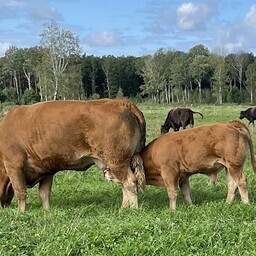Liigume üle Emajõe Tartu või Ilmatsalu poole. Seal on
Ilmatsalu luht
. Viime väikse karja loomi sinna. Need loomad pole seal varem käinud. Täna on
esimene kord
. Ma usun, et nende jaoks on see luht nagu luht ikka, ütles Viljar Ilves,
pärandniitude majandaja
.
Ilmatsalu luht
Tõlge fraasile: Ilmatsalu luht
EN
Ilmatsalu floodplain
esimene kord
Tõlge fraasile: esimene kord
EN
first time
pärandniitude majandaja
Tõlge fraasile: pärandniitude majandaja
EN
manager of heritage meadows
Suur osa Alam-Pedja luhtadest on hooldamata. Novembris valmis
heinaparv
. Sellel kevadel kasutati seda esimest korda. Parv aitab viia kariloomi ja
niidutehnika
t sinna, kuhu maismaalt ei pääse. Parv võimaldab ka heina ära tuua.
heinaparv
Tõlge fraasile: heinaparv
EN
hay raft
niidutehnika
Tõlge fraasile: niidutehnika
EN
mowing equipment
Me räägime 4000 hektarist luhast. Praegu on umbes 1000 hektarit. Üle poole neist on juurdepääsmatud. Me räägime sadadest hektaritest, mida nüüd hakkame kasutama, selgitas Ilves.
Parvega on juba proovisõite tehtud. Esimene sõit loomadega oli põnev ka
laeva kapten
ile. Esmakordne elamus sellise laevaga sõita Emajõel andis hea tunde. Laeval olid suured loomad ja väiksed kahepäevased vasikad. Nad said nüüd
heinamaale heina näksida
. See oli
tore vaatepilt
, ütles kapten Andres Põhjala.
laeva kapten
Tõlge fraasile: laeva kapten
EN
ship captain
heinamaale heina näksida
Tõlge fraasile: heinamaale heina näksida
EN
to graze on the hayfield
tore vaatepilt
Tõlge fraasile: tore vaatepilt
EN
great sight
Sellise laeva juhtimine ei ole igapäevane. Kui ilm lubab, jäävad veised
sügiseni luhale heina nautima
.
sügiseni luhale heina nautima
Tõlge fraasile: sügiseni luhale heina nautima
EN
enjoy hay on the floodplain until autumn
We are crossing the Emajõgi River towards Tartu or Ilmatsalu. There is the Ilmatsalu meadow. We are taking a small herd of animals there. These animals have never been there before. Today is the first time. I believe that for them, this meadow is just like any meadow, said Viljar Ilves, the manager of heritage meadows.
A large part of the Alam-Pedja floodplains is unmanaged. The hay barge was completed in November. This spring it was used for the first time. The barge helps transport livestock and mowing equipment to areas inaccessible by land. The barge also allows the hay to be brought back.
We are talking about a 4000-hectare meadow. Currently, about 1000 hectares are managed. More than half of them are inaccessible. We are talking about hundreds of hectares that we will now start using, explained Ilves.
The barge has already been tested. The first trip with animals was exciting even for the ship's captain. The first experience of sailing such a ship on the Emajõgi River gave a good feeling. On board were large animals and small two-day-old calves. They now got to nibble on hay in the meadow. It was a beautiful sight, said Captain Andres Põhjala.
Operating such a ship is not an everyday occurrence. If the weather permits, the cows will stay on the meadow until autumn to enjoy the hay.

